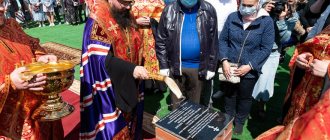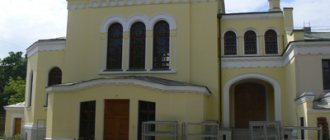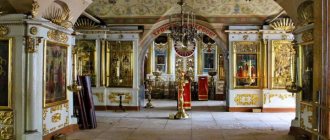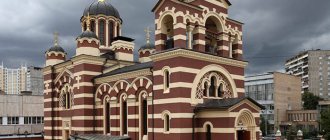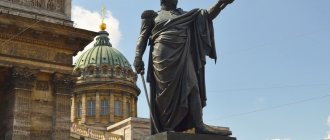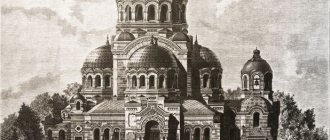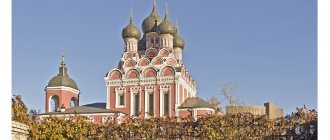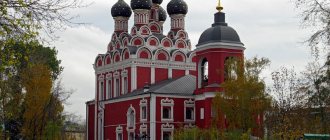Mir
Russia Moscow Temple of the Iveron Icon of the Mother of God on Vspolye (Moscow) Map is loading…
{"format":"leaflet","minzoom":false,"maxzoom":false,"limit":50,"offset":0,"link":"all","sort":[""], "order":[],"headers":"show","mainlabel":"","intro":"","outro":"","searchlabel":"\u2026 \u0441\u043b\u0435\ u0434\u0443\u044e\u0449\u0438\u0435 \u0440\u0435\u0437\u0443\u043b\u044c\u0442\u0430\u0442\u044b","default":"","import-annotation":false,"width ":"auto","height":"350px","centre":{"text":"","title":"""link":"""lat":55.736277999999998655766830779612064361572265625,"lon": 37.62486100000000277532308246009051799774169921875,"icon":""},"title":"","label":"","icon":"","lines":[],"polygons":[],"circles":[ ],"rectangles":[],"copycoords":false,"static":false,"zoom":8,"defzoom":14,"layers":["OpenStreetMap"],"image layers":[] ,"overlays":[],"resizable":false,"fullscreen":true,"scrollwheelzoom":true,"cluster":false,"clustermaxzoom":9,"clusterzoomonclick":true,"clustermaxradius":80, "clusterspiderfy":true,"geojson":"","clicktarget":"","showtitle":true,"hidenamespace":false,"template":"","userparam":"","activeicon": "","pagelabel":false,"ajaxcoordproperty":"","ajaxquery":"","locations":[{"text":"\u003Cb\u003E\u003Ca href=\"/palomnik/%D0% A5%D1%80%D0%B0%D0%BC_%D0%98%D0%B2%D0%B5%D1%80%D1%81%D0%BA%D0%BE%D0%B9_%D0%B8% D0%BA%D0%BE%D0%BD%D1%8B_%D0%91%D0%BE%D0%B6%D0%B8%D0%B5%D0%B9_%D0%9C%D0%B0%D1% 82%D0%B5%D1%80%D0%B8_%D0%BD%D0%B0_%D0%92%D1%81%D0%BF%D0%BE%D0%BB%D1%8C%D0%B5_( %D0%9C%D0%BE%D1%81%D0%BA%D0%B2%D0%B0)\» title=\»\u0425\u0440\u0430\u043c \u0418\u0432\u0435\u0440\u0441\ u043a\u043e\u0439 \u0438\u043a\u043e\u043d\u044b \u0411\u043e\u0436\u0438\u0435\u0439 \u041c\u0430\u0442\u0435\u0440\u0438 \ u043d\u0430\u0412\u0441\u043f\ u043e\u043b\u044c\u0435 (\u041c\u043e\u0441\u043a\u0432\u0430)\»\u003E\u0425\u0440\u0430\u043c \u0418\u0432\u0435\u0440\u0441 \u043a\u043e\u0439\u043a\u043e\u0439\ u0438\u043a\u043e\u043d\u044b \u0411\u043e\u0436\u0438\u0435\u0439 \u041c\u0430\u0442\u0435\u0440\u0438 \u043d\u0430 \u0412\ u0441\u043f\u043e\u043b\u044c\ u0435 (\u041c\u043e\u0441\u043a\u0432\u0430)\u003C/a\u003E\u003C/b\u003E\u003Chr /\u003E\u003Ca href=\"/palomnik/%D0%A1%D0%B2% D0%BE%D0%B9%D1%81%D1%82%D0%B2%D0%BE:%D0%90%D0%BD%D0%BD%D0%BE%D1%82%D0%B0%D1 %86%D0%B8%D1%8F\" title=\"\u0421\u0432\u043e\u0439\u0441\u0442\u0432\u043e:\u0410\u043d\u043d\u043e\u0442\u0430\u0446\u0438\ u044f\u003E\u0410\u043d\u043d\u043e\u0442\u0430\u0446\u0438\u044f\u003C/a\u003E: »'\u0425\u0440\u0430\u043c \u0418\u0432\u 0435\u0440\u0441 \u043a\u043e\u0439 \u0438\u043a\u043e\u043d\u044b \u0411\u043e\u0436\u044c\u0435\u0439 \u041c\u0430\u0442\u0435\u0440\u0438 \u043d\u0430 \u0412\u0441\u043f \u043e\u043b\u044c\u0435"' \u2014 \u043f\u0440\u0430\u0432\u043e\u0441\u043b\u0430\u0432\u043d\u044b\u0439 \u0445\u0440\u04 30\u043c\u041c\u043e\u0441 > u041c\u043e\u0441\u043a\u043e \u0432\u0441\u043a\u043e\u0439 \u0435\u043f\u0430\u0440\u0445\u0438\u0438. \u0425\u0440\u0430\u043c \u044f\u0432\u043b\u044f\u0435\u0442\u0441\u044f \u043f\u0430\u043c\u044f\u0442\u043d\u0438\u043a\ u043e\u043c\u0430\u0440\u0445 \u0438\u0442\u0435\u043a\u0442\u0443\u0440\u044b \u043a\u043e\u043d\u0446\u0430 XVIII \u0432\u0435\u043a\u0430, \u0430\u0432\u0 442\u043e\u0440\u0441\u0442 \u0432\u043e\u043f\u0440\u043e\u0435\u043a\u0442\u0430 \u043f\u0440\u0438\u043f\u0438\u0441\u044b\u0432\u0430\u0435\u0442\ u0441\u044f\u0418. \u0412. \u0415\u0433\u043e\u0442\u043e\u0432\u0443.","title":"\u0425\u0440\u0430\u043c \u0418\u0432\u0435\u0440\u0441\u043a\u043e\u0439 \u0438\u043a \u043e\u043d\u044b \u0411\u043e\u0436\u0438\u0435\u0439 \u041c\u0430\u0442\u0435\u0440\u0438 \u043d\u0430 \u0412\u0441\u043 f\u043e\u043b\u044c\u0435 (\ u041c\u043e\u0441\u043a\u0432\u0430)","link":"","lat":55.736277999999998655766830779612064361572265625,"lon":37.624861000000002775323 08246009051799774169921875,"icon":""}],"imageLayers":[]}
55.73627; 37.624732
Russia, Moscow, Bolshaya Ordynka street, 39
Moscow
Russia
Telephone:
+7 (495) 959-17-56
Temple of the Iveron Icon of the Mother of God on Vspolye
- Orthodox church of the Moskvoretsky deanery of the Moscow diocese. The temple is an architectural monument of the late 18th century, the authorship of the project is attributed to I.V. Egotov.
History[edit]
Church of the Great Martyr St. George the Victorious in Vspolye existed before the Romanovs, received a ruga (church land allocated for the maintenance of the entire clergy).
The wooden church has been documented since 1625 and was called Georgievskaya, and since 1802 - Iverskaya, which is on Vspolye, in Ordyntsy, at the Serpukhov Gate, on Ordynka, on Spolye.
St. George's Church, on Vspolye, was listed in the parish salary books for 1628 as “residential” and was initially made of wood. It is this date that is currently considered the date of formation of the Parish of the Temple.
On the site of a wooden church mentioned in the “Building Books” of 1657 (17th century), a stone church of the same name was built around 1672-1673. In the temple there was a zinc cross with an inscription stating that the stone church was built by guest (merchant) Semyon Potapov, and the consecration took place on December 14, 1672.
The first brick church of the Great Martyr George on Vspolye, erected at the expense of the merchant Semyon Potapov, is mentioned without chapels in the scribe book of the city of Moscow in 1679-1681. Under 1722, the St. George Church is already listed with the chapel of John the Warrior - stone.
In the Moscow Act Books of the early 18th century there are references to buildings on the land of the Church of St. George on Vspolye, which was rented out, and to the courtyards of the church clergy. Therefore, the size and configuration of the land ownership of the Church of St. George in Ordyntsy as a whole took shape in the 17th century, and even then the church site overlooked both Bolshaya Ordynka and Malaya Ordynka.
On the Moscow plan of 1767, which reflected the situation at the end of the 1740-1750s, the Church of St. George is depicted on a large area free of buildings, located between Bolshaya and Malaya Ordynka. To the north of the temple there was a dead end that did not reach Malaya Ordynka. Church courtyards were located along it. The lack of development is apparently explained by its disappearance during the Moscow fire of 1748. The temple stood indented from the line of Bolshaya Ordynka.
At the end of the 18th century, the parish of the Church of St. George on Vspolye included the courts of wealthy representatives of the nobility and almost no merchants.
From the south lived the Kireevskys, opposite - the Savinovs, Bibikovs, Meshcherskys, further away - the Kochetovs, Bezobrazovs, Narbekovs, Durovs, Muranovs. In the clergy register of 1785, 17 parish courtyards are recorded for the church, and it is also indicated that the courtyards of a priest, a deacon, two sextons and a sexton are located on the church land. The possession of the Church of St. George on Vspolye at the end of the 18th century was in the Fourth police part of Moscow, in the fifth quarter, and from the beginning of the 19th century - in the Pyatnitskaya part, in the fourth quarter.
In May 1791, priest Vasily Nikitin and the parish people submitted a petition to Metropolitan Platon asking for permission “to arrange a chapel in the meal in the name of the Most Holy Theotokos of Iveron.”
The petitioners received permission by the resolution of Metropolitan Plato: “permit.” On the basis of the said resolution, the refectory with two chapels, as well as the bell tower, were rebuilt and consecrated by Abbot Sergius of the Moscow Holy Cross Monastery. “The chapel in the name of the Iveron Mother of God was consecrated on January 15, and the other, in the name of John the Warrior, on January 23, 1794, on the consecrated antimensions issued from the Chudov Monastery.”
In April 1798, a parishioner of the Temple, Captain Ivan Ivanov Savinov, in a petition submitted to Metropolitan Plato, wrote that “the real St. George’s Church has not been rebuilt and due to its dilapidation, priestly services are held in the chapels and that he has a zealous desire to rebuild again with his own money the St. George’s Church with a stone building and to the same name."
1798, April 12, according to the resolution of Metropolitan Plato: “The Eminence will consider, and if there are no obstacles, he will bless you,” a decree was issued from the Moscow Spiritual Consistory in the name of the Dean of Nikolaev, in Studenets, the church of Peter Alekseev “on permission to the petitioner to build again in stone the building designated St. George’s Church according to the established plan and facade.” Clergy records date the construction of St. George's Church to 1802.
The church building, which had stood for more than a hundred years, was in need of serious repairs. The parishioners decided to radically rebuild it, but in fact they built a new temple. The construction was financed by the church elder, adjutant wing of Field Marshal Count Kirill Grigorievich Razumovsky - Ivan Ivanovich Savinov. Captain Savinov lived opposite the church, on the other side of Bolshaya Ordynka, in the 4th quarter of the Yakimansk part, in a large stone three-story house, which he inherited from his father. The building has been preserved in its rebuilt form (in the depths of property No. 40 on Bolshaya Ordynka).
It is known that at first a new refectory was built with two chapels - St. John the Warrior and the Iveron Icon of the Mother of God. The plan of the courtyard by I. I. Savinov in 1792 shows the western part of the church yard with a wide new refectory with rounded corners. On the plan of the church site from 1797, the temple is depicted with the old eastern part (with a three-apse altar) and a new refectory protruding onto the line of Bolshaya Ordynka. In this plan, the line of church buildings stretches along Georgievsky Lane. The construction of church courtyards was wooden.
Thus, the new church was built in two stages and on the same site. In 1802, construction was completed: a new rotunda church was erected, a bell tower rose above the western part of the refectory, a brick fence with two pairs of gates and metal bars stretched along the sides of the church along Bolshaya Ordynka to the alley on one side and to the Kireyevskys’ property on the other, which was later erected the same fence along the alley. The main temple was consecrated in honor of the Iveron Icon of the Mother of God, and the left side chapel was re-consecrated in the name of the Great Martyr George. Over time, Georgievsky Lane was renamed Iversky.
The authorship of the Iveron Church is attributed to the chief director of the Kremlin drawing expedition, architect I. V. Egotov.
The copy from the Iveron Icon, which was a substitute for the famous image of the Iveron Mother of God, located in the Iveron Chapel at the Resurrection Gate, was transferred to the newly built temple. This substitute list was exhibited instead of the main image in this chapel in cases where the permanent image was taken for religious processions, or was exhibited in churches and monasteries in Moscow and Russia for solemn worship and prayers.
From this list, another list was made in 1792, which ended up in 1802 in the newly built Church of the Iveron Icon of the Mother of God, on Bolshaya Ordynka. The brief history of this temple icon is as follows: on the front side of it below it is written: “the true image and measure of the Miraculous Image of the Most Holy Theotokos of Iveron, which is found in the reigning city of Moscow on Tverskaya Street, in the chapel at the Resurrection Gate, and was painted in 1792, and was written by this image of the Ivanovo Forty, Church of St. Nicholas the Wonderworker in Podkopayi, priest Vasily Ivanov.” For 10 years (from 1792 to 1802, when the real Iveron Temple was consecrated) this icon was a substitute for the main Moscow shrine, which was located in the chapel at the Resurrection Gate.
During the Moscow fire of 1812, Zamoskvorechye suffered greatly. Undoubtedly, all the wooden buildings of the churchyards perished. In 1813 and 1814, the chapels in the plundered Iversky Church were re-consecrated.
In 1886, through the diligence of the church warden, merchant Druzhinin, and with the bequeathed funds (11,300 rubles) of hereditary honorary citizens Nikolai Vasilyevich and Daria Artemyeva Nemirov-Kolodkin, according to the design of the architect N. N. Vasilyev, a new stone two-story almshouse was built on the corner of Malaya Ordynka and Iversky Lane.
In 1888, another church house was erected on the Malaya Ordynka line, wooden, paneled, with classic decor and a metal comb on the roof (architect V.V. Karkov). It was connected by a fence to the almshouse building. At the end of the 19th century, only small buildings were erected on the church grounds.
In 1892, in the Iveron Church on Ordynka there was a solemn service on the occasion of the minor consecration of this temple and the 100th anniversary of the painting of the local temple icon of the Iveron Mother of God. On this occasion, the Moscow Church Gazette wrote: “This temple, restored in all its parts, splendidly decorated with the efforts and resources of the late elder, hereditary honorary citizen Nikolai Vasilyevich Nemirov-Kolodkin, was consecrated in 1885, January 27th, by His Eminence Alexy.
This year, at the expense of the church warden, hereditary honorary citizen Alexander Nikolaevich Druzhinin (nephew of the deceased Nemirov-Kolodkin), a major washing, cleaning and repair of the entire temple was carried out, with the replacement of some dilapidated and simple things with new, expensive and elegant ones, so that for everyone The rather large and numerous icons of this temple are now massive, expensive and artistically made in the Nemirov-Kolodkin’s own factory with silver-gilded vestments. The consecration of the temple with a late liturgy and the night before the all-night vigil was performed by the local Father Blagochinny, Archpriest of the Trinity Church in Vishnyaki A. A. Dobrogorsky with priests of the Trinity Church in Luzhniki A.S. Voskresensky and local - N. Myachin, under the deacon of the Cathedral of Christ the Savior Sokolsky.
During the sacramental verse, Priest Myachin said a word befitting a celebration, in which a parallel was drawn between the joyful greeting of the rights of Elizabeth, “Where do I get this, that the Mother of My Lord may come to me,” and the joyful feelings of the ancient ascetics of the Iveron, on Athos, monastery, who received miraculously appeared at sea the icon of the Mother of God, - the joyful meeting in 1648, on October 13, by the residents of Moscow from Athos brought a copy (list) from the holy icon of Iveron and, finally, the joyful feelings of parishioners and temple lovers that the Mother of God in her locally revered miraculous icon is in This temple is not 3 months old, but already a hundred years old.”
In 1893, the appearance of the temple was slightly changed - buildings appeared between the side porches of the main temple and the eastern walls of the aisles.
On Sunday, October 30, 1899, in the Church of the Iveron Mother of God, a chapel was consecrated in honor of the Great Martyr. St. George the Victorious. This chapel was decorated at the expense of the deceased parishioner Lebedeva. The three-tiered iconostasis was again gilded, and the wall paintings were resumed. Behind the right choir there is a large icon donated by one of the parishioners depicting the Saints, whose incorruptible relics rest in Moscow. At the top of the icon is an image of the Vladimir Mother of God in a silver-gilded frame with precious stones.
On Sunday, March 26, 1900, in the Moscow Iverskaya Church on Ordynka, a solemn service was held on the occasion of the small consecration of the main Iversky Church, “newly painted and beautifully decorated with gilding of all iconostases, and decorated at the expense of the Moscow merchant Nikolai Kirillovich Lebedev, who donated for this item together with his parents 30 thousand rubles. The rite of consecration and the late liturgy, and the day before the all-night vigil, were performed by the priest of the Trinity Church in Luzhniki, Fr. A.S. Resurrection with the local clergy, with the participation of Protodeacon of the Assumption Cathedral A.Z. Shekhovtsov and a full choir of singers.
In 1910, the church celebrated the 25th anniversary of the priesthood of Father Rector N.I. Myachin: “On the third day of Holy Easter, April 20th, the parishioners of Iverskaya, on Bolshaya Ordynka, church, with the blessing of His Eminence, honored their rector Fr. Nikolai Ivanovich Myachin, on the occasion of his 25th anniversary of serving as a priest on February 26 of this year. After completing the course at the Moscow Theological Academy in 1882, Nikolai Ivanovich spent 2.5 years as an assistant inspector at the Bethany Theological Seminary, and in 1885, His Eminence Ioannikiy was appointed rector of the Iveron Church, where he still serves as a priest, at the same time being a teacher of the law at the State Real School and the private girls' gymnasium Gilbich.
The Divine Liturgy on the day of the anniversary celebration in the Iveron Church was performed by local Fr. Dean Archpriest N.A. Kopiev in the concelebration of the hero of the day and priests: Basil-Caesarean Church A.I. Razumikhin and the Church of the Alekseevsky Monastery A.P. Afonsky.
At the end of the liturgy, Fr. The dean addressed the parishioners and admirers of the hero of the day gathered in the church with an edifying word, in which he vividly depicted the modern attitude - very often disrespectful and even hostile - towards the pastors of the church, although they are all, according to the height of their rank, worthy of honor, and expressed gratitude for the attention to the servant of this temple, which should be highly valued, especially in our time...
The October Revolution of 1917 and the subsequent persecution of the Church of Christ fully affected the temple.
The bell tower was destroyed. The unique frescoes by the Belousov brothers, who also painted the Faceted Chamber of the Moscow Kremlin, were barbarously painted over, and in some places they tried to knock down the frescoes.
Floors were erected in the Temple, all 3 iconostases were completely destroyed. Most of the icons were burned. The temple was plundered; in Soviet times, about a ton of silver (robes, icon frames, liturgical utensils) was taken from it.
On Tuesday of Bright Week 1918, His Holiness Patriarch Tikhon celebrated the Liturgy in the Church of the Iveron Mother of God on Ordynka. At the end of the liturgy, a religious procession with artos was held around the temple.
The Temple was finally closed in 1929.
After the closure of the temple, the upper tiers of the bell tower were destroyed, the head of the church and the fence were demolished. The interior decoration has been lost, early paintings have been covered up and partially knocked down, interfloor ceilings have been installed, additional windows have been broken, and an extension has been built to the south.
Old Muscovites well remember the cinema on Bolshaya Ordynka, set up in house No. 39, in the building of the temple in honor of the Iveron Icon of the Mother of God, devoid of a dome and a bell tower. In the first years of perestroika, these premises were used for the exhibition of contemporary art.
Church houses were used for housing and for the needs of various organizations. In the premises of the temple there was first a club, then a cinema, then exhibition halls of the cultural center.
Restoration of the temple began in 1990 according to the design of architects S. V. Konev, P. Shchenkova; engineer V. M. Kabanov (design and restoration bureau "Fatherland"). The interfloor ceilings were dismantled and the broken openings were filled in. Using photographs and archival drawings, the original architectural appearance of the temple was restored, the destroyed tiers of the bell tower and the head of the temple were recreated. Restoration work continues. To complete the restoration work and restore the remaining fragments of internal painting, large amounts of money are needed.
By Decree of the Moscow Government of March 2, 1993 No. 167, the church building was transferred to the Moscow Patriarchate in the person of the parish of the Church of the Iveron Icon of the Mother of God.
The temple reopened in 1994.
Unfortunately, the Parish of the Church of the Iveron Icon of the Mother of God on Vspolye still has not legally received the entire historical church territory, as well as the two church houses standing on it.
After the Revolutions, the Church of the Iveron Icon of Our Lady is converted into a club
As already mentioned, the church on Bolshaya Ordynka did not undergo radical reconstruction during the 19th century and was only slightly renovated. It was in its original form that it stood until the February bourgeois revolution and the Great October Revolution.
And although a number of churches began to be dismantled in the early twenties of the 20th century, this temple continued to function until 1930. It was this year that they finally got to him. By order of the governing bodies, the bell tower was demolished, the entire interior decoration and even part of the exterior were dismantled.
After the work was carried out, the devastated building was transferred to the ownership of the carriage repair plant. The management of the enterprise used the building at its own discretion and organized a club in the temple for the leisure of its employees.
A little later, the building was transferred to the Ministry of Culture.
The Ministry of Culture found a more worthy purpose for the building of the former church - they organized a museum of modern art inside it. For these purposes, the domed space was divided into three floors.
The temple celebrated its 200th anniversary in 2002.
The temple was returned back to the Russian Orthodox Church only in 1994. It was in excellent condition. Later, everything unnecessary inside was dismantled, the decoration was returned, and the altar and chapels were re-consecrated.
Now the temple is functioning. A monument called “Renaissance” was erected next to the church in 2000.
Description[edit]
The two verticals of the Iverskaya Church are part of the ensemble of architectural accents of Zamoskvorechye. The building belongs to the type of Moscow churches developed in the 1780s in the style of mature classicism, the composition of which is dominated by rounded outlines. The monument is characterized by the wide use and variety of order forms. A cylindrical drum with a dome rises above the dome of a slender two-tier rotunda. The height of the first tier is created by a group of volumes surrounding the rotunda: an apse with rounded corners, side porches with arched portals processed by two pairs of Tuscan columns, and a refectory with two oval-shaped aisles.
The lower tier of the bell tower rises from the volume of the refectory, above which rises a cylindrical bell tier, topped with a spire. In front of the western entrance there is a four-column Ionic portico with a pediment.
A unique planned solution for the base of the bell tower with two rooms of an oval configuration. The Palladian arch motif of the side entrances is repeated in the form of the graceful upper windows of the rotunda. The eastern façade is finished with vertical and horizontal niches. The upper tier of the bell tower is decorated with pilasters of the Corinthian order. The cornices and drafts are made of white stone, the capitals are molded. The interior contains fragments of glue and oil wall paintings from the original period and the second half of the 19th century.
The complex of the Church of the Iveron Icon of the Mother of God on Vspolye is of great artistic value due to the interesting features of the temple - one of the best examples of Moscow classicism of the late 18th and early 19th centuries and its extremely important urban planning role in the structure of Zamoskvorechye.
The legend of the underground passage
An ancient legend says that the banks of the Moscow River are connected by an underground passage. The secret entrance to the dungeon went from the Kazan Church in Kolomenskoye to the Nikolo-Perervinsky Monastery. It was created so that, if necessary, the king had the opportunity to take refuge in a monastery on the other side.
Local residents knew about this move. In the 20s of the twentieth century, people told this legend to the archaeologist Stelletsky, who studied the secrets of old Moscow. The scientist found two corridors from the altar of the Kazan Church, which led to the basement. But work on studying the passages was stopped already in the 30s, since archaeological excavations near the walls of the temple threatened to destroy it. The underground passage under the river still remains unexplored.
View of the monastery from the Moskva River
Shrines[edit]
Iveron Icon of the Virgin Mary
- Miraculous Icon of the Mother of God of Iveron
- Icon of the Mother of God Inexhaustible Chalice
- Reliquary
- Icon of the Righteous Simeon of Verkhoturye with a particle of his relics
- Icon of the Venerable Seraphim of Sarov and Sergei of Radonezh with a particle of the relics of Seraphim of Sarov
- Icon of St. Luke with a particle of his relics
- Icon of the Great Martyr and Healer Panteleimon with a particle of his relics
- Icon of the Venerable Martyrs Elizabeth and Barbara with particles of their relics
- Icon of the Holy Great Martyr George the Victorious with a particle of his relics
- Icon of St. Maximus the Greek with a piece of his relics
What is the Iveron Icon of the Intercessor
The main altar of the temple on Bolshaya Ordynka was consecrated to the glory of the Iveron Icon of the Blessed Virgin Mary. The original icon is kept in the Iveron Monastery on Holy Mount Athos, from where it got its name.
The image of the Virgin Mary holding the baby Jesus in her arms is believed to be miraculous and full of grace. The exact dates of the painting of the icon vary, but the historian of the University of Instbruck, Thomas Steppan, dates its creation to the beginning of the seventh century, and Nikodim Kondakov simply to the 7th century.
The Iveron Icon of the Mother of God or the Gatekeeper dates back to the 7th century AD. Now it is located in the Iveron Monastery of Athos. According to legend, she saved the monks from Persian pirates and starvation
How does the Iveron Icon of the Mother of God help?
Let's start with one story.
Mount Athos is located near the shores of the Mediterranean Sea. And this sea at that time was simply teeming with pirates and dashing people. The monasteries of the Holy Mountain were often raided by these scoundrels, which led to their ruin.
One day, Persian pirates decided to rob the Iveron Monastery. The monks, bound by vows, could not give a worthy rebuff and only fervently prayed to the icon of the Mother of God for protection.
The prayer was so strong that after some time a storm broke out and sank the ships of the invaders. Since then, the icon has often been approached with a plea for intercession. They even began to call her that - the Intercessor or the Gatekeeper.
So, what do they pray for before the icon of the Iveron Intercessor:
- First of all, about healing from diseases and illnesses;
- About protection from attacks by dashing people and barbarians;
- Oddly enough, about replenishing the cellars with supplies.
Text of the prayer before the face of the Mother of God on the Iveron icon for protection and healing:
O Most Holy Virgin, Mother of the Lord, Queen of heaven and earth! Hear the much-painful sighing of our souls, look down from Thy holy height upon us, who with faith and love worship Thy most pure image. Behold, immersed in sins and overwhelmed by sorrows, looking at Your image, as if You were alive and living with us, we offer our humble prayers. Imams have no other help, no other intercession, no consolation except You, O Mother of all who mourn and are burdened! Help us, the weak, satisfy our sorrow, guide us, the erring, on the right path, heal and save the hopeless, grant us the rest of our lives to spend in peace and silence, grant us a Christian death and appear to us at the Last Judgment of Your Son, merciful Intercessor, yes We always sing, magnify and glorify Thee, as the good Intercessor of the Christian race, with all those who have pleased God. Amen.
Second prayer, appeal to the face of the Intercessor on the Iveron Icon:
Oh, Most Holy Lady and Lady Theotokos! Accept our unworthy prayer, and save us from the slander of evil people and from sudden death, and grant us repentance before the end. Have mercy on our prayer and grant joy instead of sorrow. And deliver us, Lady, from all misfortune and adversity, sorrow and illness, and from all evil. And grant us, Thy sinful servants, to the right hand at the Second Coming of Thy Son, Christ our God, and heirs of the existence of the Kingdom of Heaven and eternal life with all the saints throughout the endless ages of ages. Amen.
Troparion, tone 1:
“From your holy icon, O Lady Theotokos, healing and healing are given abundantly to those who come to her with faith and love. So visit my weakness and have mercy on my soul, O Good One, and heal my body with Your grace, O Most Pure One.”
Kontakion, tone 8:
“Thy holy icon, Mother of God, was cast into the sea from a widow who could not save her from her enemies, but the guardian of Athos and the goalkeeper of the Iveron monastery appeared, frightening enemies and in the Orthodox Russian country who reveres You from all troubles and misfortunes. Greatness We magnify Thee, Most Holy Virgin, and honor Thy holy image, through which we heal our illnesses and raise our souls to God.”
By leaving a comment, you accept the user agreement
Interior decoration
The monastery has the status of a patriarchal metochion. The monastery is surrounded by a fence and has two gates. In addition to churches, on the territory of the monastery there are monastic buildings, outbuildings, a children's Sunday school, buildings for seminarians and the bishop, and the ancient cells of the patriarch. The monastery is surrounded by dense greenery.
The cathedrals have rich gilded iconostases. A large number of windows in temples provide a lot of light. The walls are covered with rich paintings, the windows are decorated with stained glass.
Several styles can be traced in the design of the Nikolo-Perervinskaya monastery - baroque, classicism and modernity.
